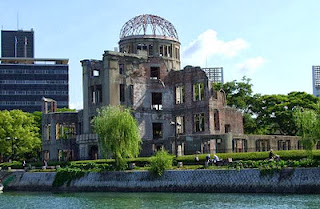At
8:15 in the morning of August 6, 1945, the world’s first atomic bomb was
launched by the United States military on the city of Hiroshima. The bomb
exploded 600 meter above the city, scorching everything within a 2-kilometer
radius and claiming over 200,000 lives. Due to its location a mere 160 meters
away from the epicenter of the explosion, the Hiroshima Prefectural Industrial Promotion
Hall received the full impact of the blast from directly overhead. However, the
main portion of the building miraculously escaped total destruction. Now known
as the Genbaku Dome in the Hiroshima Peace Memorial Park, the remains of the
building have been inscribed on UNESCO’s World Heritage List.
The Industrial Promotion Hall was
built in 1915 as the Hiroshima Prefectural Products Exhibition Hall. During
World War II, it was used as a satellite office for Japan’s government administrative agencies. The personnel who
were in the building at the time of the explosion are thought to have been
killed instantly. At some point after the war, local residents began calling
the building the Genbaku Dome.
As the world’s first city to suffer
an atomic bombing, Hiroshima City has issued a number of peace declarations
since the end of the war that appeal for lasting peace. As a result of a
campaign the city carried out to have the Dome added to the World Heritage
List, the site was inscribed in December 1996 as World Cultural Heritage. It
was accepted under the criterion that it “ be directly or tangibly associated
with events or living traditions, with ideas, or with beliefs or outstanding
universal significance”.
“When I first saw the Genbaku Dome,
I was amazed by the fact that the damage from the precise moment of the atomic
blast had been completely preserved as a monument,” say Narayanan Ganesan, an
associate professor at the Hiroshima Peace Institute from Singapore who is
conducting research on Southeast Asian politics and international relations,
describing his first impression of the Dome. “It is a special example of World
Heritage in that it is not simply a purely cultural manument, as in the case of
Indonesia’s Borobudur Temple ruins or Cambodia’s Angkor Wat; it is also a
testimony to the negative side of humanity. In the World Heritage Committee’s
deliberations, there were countries such as the United States and China that
opposed the inscription of the site. However, I think that the international community
understands that Japan nominated the Genbaku Dome as World Heritage not to
justify its actions in the war but to have it serve as a symbol of hope for
peace.
Along with Poland’s Auschwitz Concentration
Camp, which was registered as World Heritage in 1917, the Genbaku Dome
represents humanity’s “negative heritage” while also serving as a monument
that, it is hoped, will prevent the folly of war from being repeated again.
Today, 60 years after the end of the war, we are seeing rich greenery growing
in abundance on the very spots in Hiroshima where people thought vegetation
would not grow for 70 years. It is important that we keep the significance of
the Genbaku Dome as World Heritage in our hearts forever.

Tidak ada komentar:
Posting Komentar